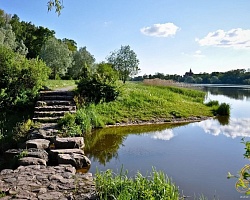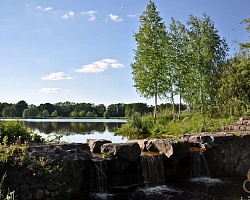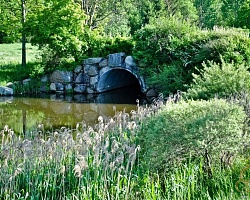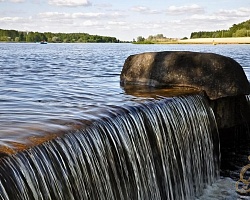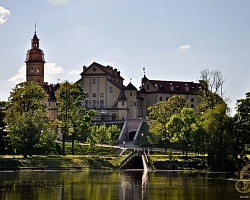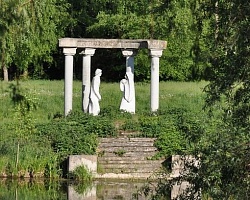Parks
 «Not a single tree, total devastation: only two old pear trees, probably the previous borders were marked that way, and over a hundred little grey shacks necessary to local people were the rare objects to lay eyes on ...». Maria Dorota de Castellane
«Not a single tree, total devastation: only two old pear trees, probably the previous borders were marked that way, and over a hundred little grey shacks necessary to local people were the rare objects to lay eyes on ...». Maria Dorota de Castellane
Some details of Niasvizh parks appeared in the times of Mikołaj Krzysztof Radziwiłł Sierotka (the Orphan). At that time there was a small «Italian garden» near the castle. In the times of Mikołaj Kazimierz Rybońka a park called Consolation was founded not far from the palace. It was one of «French parks», and small gardens were planted right at the castle walls.
A new stage in the history of Niasvizh parks is connected with Maria Dorota de Castellane. In 1865 when the princess first visited the town the territory near the castle was a sad sight. Little stalls where people sold their products on market days were its only decoration.
In the 1870s the regular work on the landscape park began, Daniel Betkher, a Polish gardener, was invited to look after it. The seedlings were brought from Berlin nursery garden and Khominka forest district (near Kletsk). On the castle earthwork there were flower gardens with a special rose variety, Marechal Niel, and also terraces and pergolas to spend leisure time. Today the green ensemble includes 5 parks: Castle Park, Old Park, Japanese Park, English Park, Marysin Park. Their total area is 66 hectares.
Castle Park includes the alleys that are located along the dam and the defensive moat shore. Old Park is located to the north-east of от the castle. At the time of its foundation in this territory there was only one poplar 28 metres high. It was there at the beginning of the 21st century, but it hasn’t survived till now (was overturned by storm). Today a memorial stone laid in the times of Maria Dorota reminds the visitors of it. The second memorial stone emphasizes how important her role in the foundation of the parks was. The third one is a memorial sign in honour of princess Radziwiłł’s 25 years of work on the creation of the parks and the castle renovation. It was laid in 1903. Legend has it that if you make a wish and touch the stone your wish will come true.
Old Park was a place for active leisure for the owners of the castle. There was a pergola there which was used as a solarium; tennis court; seasonal flower, vegetable and fruit exhibitions were organized in the Exhibition Glade. Today lots of sculptures that appeared here not long ago are the peculiarity of this park. There is a monument to a dog in the park that is said to have saved the prince from an enraged bear out hunting; sculpture of a Musician and Angel inspired by the poem Symon-Muzyka (Simon the Musician) by Yakub Kolas; statue of the Black Lady, and the Mermaid statue. There is also the Mermaid’s Well, and Humpback Bridge in the park. A monument to Niasvizh Jews killed on 30 October 1941 reminds of the events that took place here during the Great Patriotic War. 1500 town and the nearby area dwellers died at that time, mostly elderly people, women, and children. The injured fell into a moat that had been dug beforehand along with the killed. They were buried alive, despite their screams and cries. In 1965 their remains were reburied in the town cemetery. One more monument dedicated to the war events is located not far from the western bastion, at the mass grave of Soviet soldiers died during the liberation of Niasvizh. It was laid in 1903. Legend has it that if you make a wish and touch the stone your wish will come true.
In 1992 an Alley of Memory appeared in Old Park with the busts of the personalities connected with the town: princes Yuri Niasvizhski and Mikołaj Krzysztof Radziwiłł Sierotka (the Orphan), engraver Tomash Makouski, architect Yan Maria Bernardoni, poets Władysław Syrakomla and Yakub Kolas.
Japanese park was founded in 1913–1914. It was supposed to represent the exoticism of the East with winding paths, a dwarf tree garden, and stone compositions. However the work wasn’t finished, the trees didn’t survive, and today the park looks just like the other ones.
On the opposite lake shore there are English and New Parks. They are separated by a road leading from the dam. New Park is also called Marysin. This name is connected with a legend about princess Radziwiłł’s love to a poor nobleman. It’s the biggest of Niasvizh parks, with an area of 22 hectares. There is an obelisk there in honour of the foundation of the park with an inscription «Marysin 1898». The biggest part of English park was planted with lawn, and the trees were planted chequer-wise. The park was a favourite place for horse riding of the princely family.






